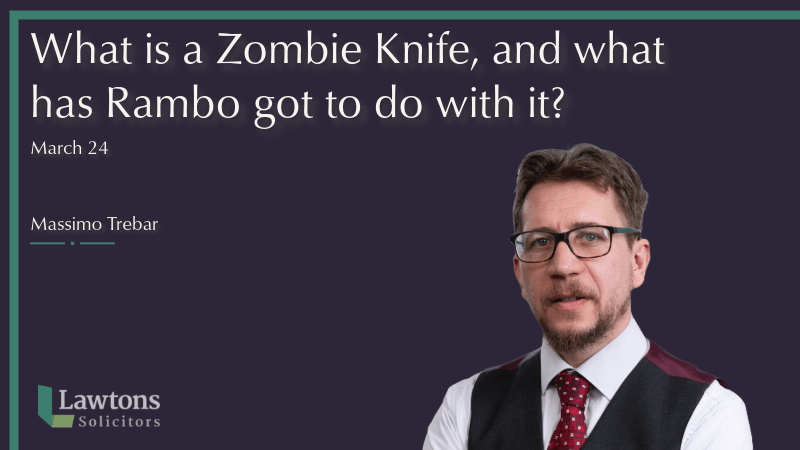In 2021, the government amended legislation to specifically outlaw so-called “zombie knives”, following continuing and escalating concerns about knife crime. Even in the news this week, three teenagers were convicted of murdering a 16-year-old at a house party in Bristol with a “Zombie Knife”.
The legislation amended section 141 of the Criminal Justice Act 1988, with the following definition of a “zombie knife” as “being a blade with —
- a cutting edge;
- a serrated edge;
and (iii) images or words (whether on the blade or handle) that suggest that it is to be used for violence.”
The first two definitions are fairly clear and uncontroversial. The third definition could be more problematic by requiring an element of interpretation.
The recent case of T-v-CPS [2024] EWHC 470 (Admin) raised this problem of interpretation. The case in question involved a knife, which was agreed by all parties to have a cutting edge and a serrated edge.
However, the knife also bore the words “Rambo First Blood Part 1”.
Additionally, the knife blade was nine inches long and the handle of the knife could be unscrewed. Inside was a compass, fishing line and a match.
The defence accepted that the knife had a cutting edge and a serrated edge but disputed that it was a Zombie knife because the reference to Rambo indicated nothing more than the name of a novel and a film that it was not Parliament’s intention to criminalise possession of film memorabilia; and that the words “Rambo First Blood Part 1” do not suggest that the knife is to be used for violence.
It may be that many people have similar “collectable” pieces – are they committing a serious offence? Another issue is whether Rambo could be fairly characterised as a “man of violence”. It is, of course, the first Rambo film, when he famously said, “They drew first blood….not me…”
It was, therefore, for the High Court to ultimately decide whether such words suggest that the knife is to be used for violence or not and whether that knife could be so defined and be prohibited under the new provisions of the Act. The High Court agreed with the District Judge’s original finding in this case that such words were within the definition set out.
As Mr Choudhury set out in the judgment;
“The third characteristic is that the knife has “images or words (whether on the blade or the handle) that suggest that it is to be used for the purpose of violence”. The definition requires an objective consideration of what the images or words in question “suggest”. The subjective intention of the person in possession is irrelevant. Thus, it matters not if the person in private possession of the knife is merely a “collector” who seeks to display the knife in a cabinet or by some other means and who has no intention of ever using it to commit or threaten violence. If the images or words on the knife in private possession suggest that it is to be used for violence, then the offence is committed”.
A second significant point concerning this case is that the knife was kept at home in the defendant’s private room. This, again, is a recent extension and development in criminal law, where possession of certain and specifically defined offensive weapons is now criminalised even if kept at home.
In light of this judgement, it is arguable that the court is now free to interpret whether such weapons could be categorised as “Zombie Knives”.
Given this recent extension of the law concerning offensive weapons, it is extremely important to have the earliest and best advice in relation to any items that may be held, even in private homes; this is particularly the case where previously members of the public may not have realised they may be committing a very serious offence just by collecting them for “show”. If you require any such advice, please contact us and we can provide the most up-to-date legal analysis in this new and changing area of law.





